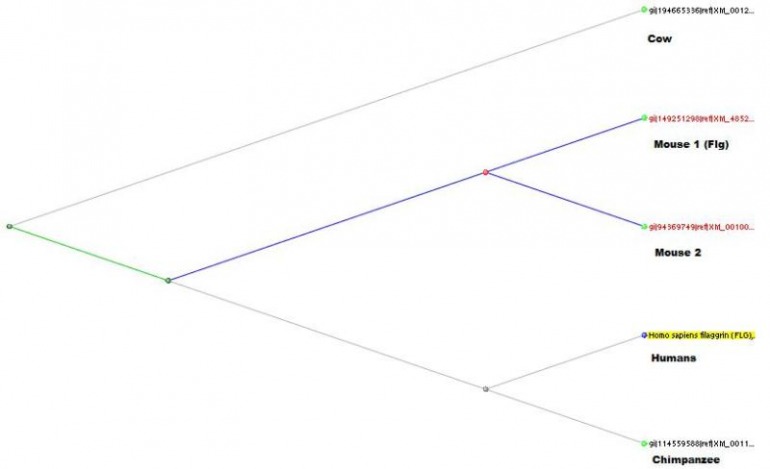Homologues of filaggrin in Homo Sapiens
Using Homologene and Wormbase, I found homologues of the human filaggrin mRNA in these species:
Using Homologene and Wormbase, I found homologues of the human filaggrin mRNA in these species:
- Chimpanzees (Pan troglodytes)
- Cattle (Bos taurus)
- House mice (Mus musculus)
| Download to view homologues in FASTA format: homologene.txt |
See the "Phylogony" page to view phylogenic trees of the data.
BLAST alignment for filaggrin
Using BLAST, I aligned the identified stretches of homologous mRNA found in Homologene and Wormbase. An E-value of 0 indicates a near perfect match in sequence similarity. Larger E-values indicate a less accurate match.
Pan troglodytes (Chimpanzee)
Name: PREDICTED: Pan troglodytes filaggrin, transcript variant 1 (FLG), mRNA
Maximum Identification: 100%
Length: 9840 bp
Accession number: XM_001134714.1
GI: 114559588
E-value: 0.0 (mega-blast)
Bos taurus (Cow)
Name: PREDICTED: Bos taurus similar to filaggrin (LOC788551), mRNA
Maximum Identification: 100%
Length: 5427 bp
Accession number: XM_001255582.2
GI: 194665336
E-value: 6e-84 (mega-blast)
Mus musculus (Mouse)
Name: PREDICTED: Mus musculus filaggrin (Flg), mRNA
Maximum Identification: 100%
Length: 11111 bp
Accession number: XM_485270.5
GI: 149251298
E-value: 1e-08 (mega-blast)
Mus musculus (Mouse)
Name: PREDICTED: Mus musculus similar to filaggrin (LOC668304), mRNA
Maximum Identification: 100%
Length: 2964 bp
Accession number: XM_001000758.1
GI: 94369749
E-value: 1e-07 (mega-blast)
Using BLAST, I aligned the identified stretches of homologous mRNA found in Homologene and Wormbase. An E-value of 0 indicates a near perfect match in sequence similarity. Larger E-values indicate a less accurate match.
Pan troglodytes (Chimpanzee)
Name: PREDICTED: Pan troglodytes filaggrin, transcript variant 1 (FLG), mRNA
Maximum Identification: 100%
Length: 9840 bp
Accession number: XM_001134714.1
GI: 114559588
E-value: 0.0 (mega-blast)
Bos taurus (Cow)
Name: PREDICTED: Bos taurus similar to filaggrin (LOC788551), mRNA
Maximum Identification: 100%
Length: 5427 bp
Accession number: XM_001255582.2
GI: 194665336
E-value: 6e-84 (mega-blast)
Mus musculus (Mouse)
Name: PREDICTED: Mus musculus filaggrin (Flg), mRNA
Maximum Identification: 100%
Length: 11111 bp
Accession number: XM_485270.5
GI: 149251298
E-value: 1e-08 (mega-blast)
Mus musculus (Mouse)
Name: PREDICTED: Mus musculus similar to filaggrin (LOC668304), mRNA
Maximum Identification: 100%
Length: 2964 bp
Accession number: XM_001000758.1
GI: 94369749
E-value: 1e-07 (mega-blast)
Analysis
As expected, the best homology is seen in the Chimpanzee, which shares the most similar skin features that Homo sapiens exhibit. Since the filaggrin gene is associated with the structure and integrity of the skin barrier, it makes sense that the Chimpanzee would show the highest conservation. The lengths of all the sequences are interesting in that they seem to increase with complexity, with the exception of the first mouse homologue. Above is a diagram of the likely tree describing the evolution of the filaggrin gene amongst the species. This follows the evolution predicted by the complexity and conservation found in by our E-values and sequence lengths. The unexpected sequence length of the first (Flg) mouse homologues brings into question whether or not it is a true homologue. In the mouse, two types of possible filaggrin homologues are found, the first with slightly higher likelihood than the second. Both homologues are interesting for future research, and the first established filaggrin homologue in mice is of particular interest, as described further in the Future Directions section.
As expected, the best homology is seen in the Chimpanzee, which shares the most similar skin features that Homo sapiens exhibit. Since the filaggrin gene is associated with the structure and integrity of the skin barrier, it makes sense that the Chimpanzee would show the highest conservation. The lengths of all the sequences are interesting in that they seem to increase with complexity, with the exception of the first mouse homologue. Above is a diagram of the likely tree describing the evolution of the filaggrin gene amongst the species. This follows the evolution predicted by the complexity and conservation found in by our E-values and sequence lengths. The unexpected sequence length of the first (Flg) mouse homologues brings into question whether or not it is a true homologue. In the mouse, two types of possible filaggrin homologues are found, the first with slightly higher likelihood than the second. Both homologues are interesting for future research, and the first established filaggrin homologue in mice is of particular interest, as described further in the Future Directions section.
References
1. Homologene http://www.ncbi.nlm.nih.gov/homologene/
2. Wormbase http://www.wormbase.org/
3. Blast http://blast.ncbi.nlm.nih.gov/Blast.cgi
1. Homologene http://www.ncbi.nlm.nih.gov/homologene/
2. Wormbase http://www.wormbase.org/
3. Blast http://blast.ncbi.nlm.nih.gov/Blast.cgi

